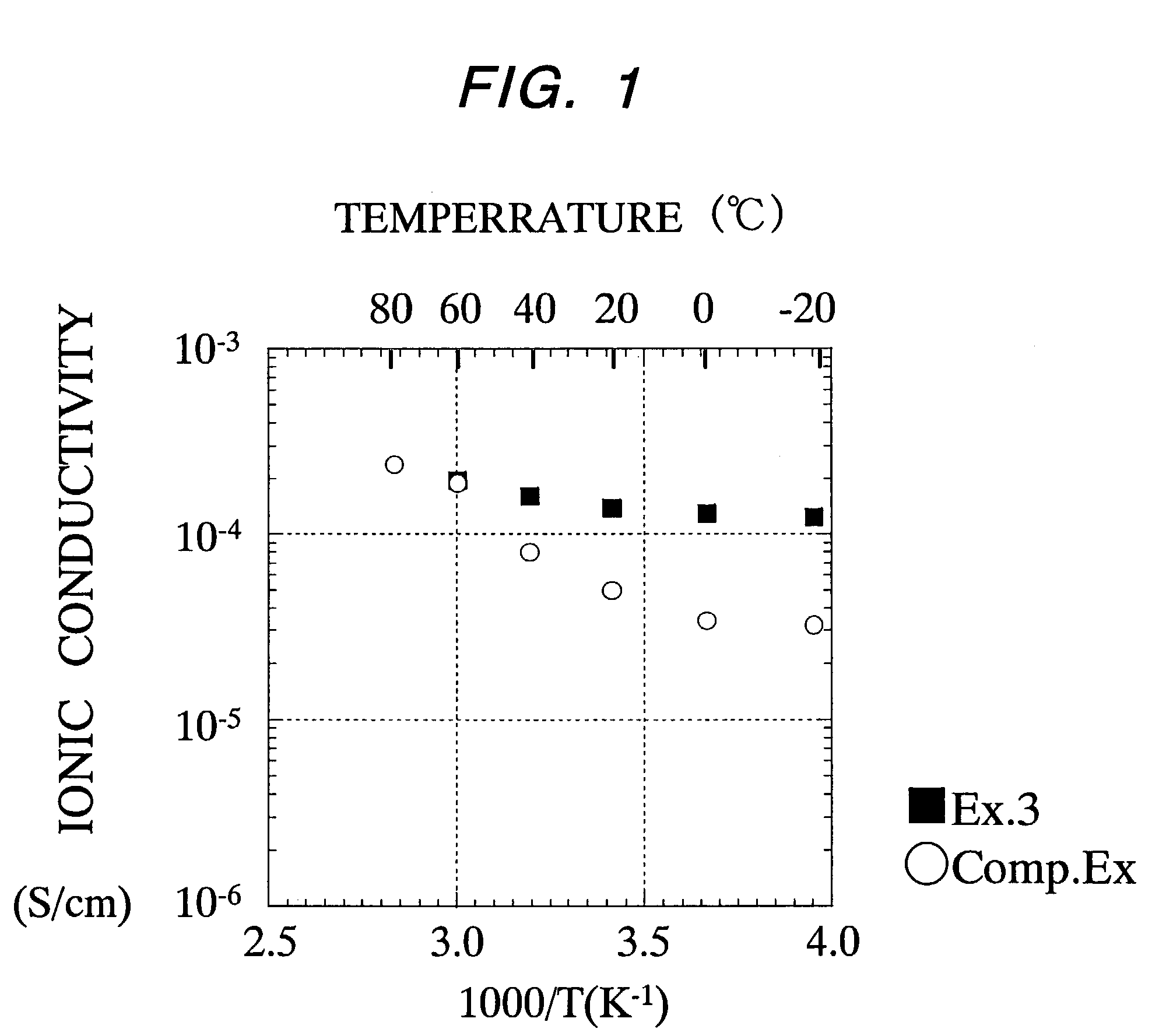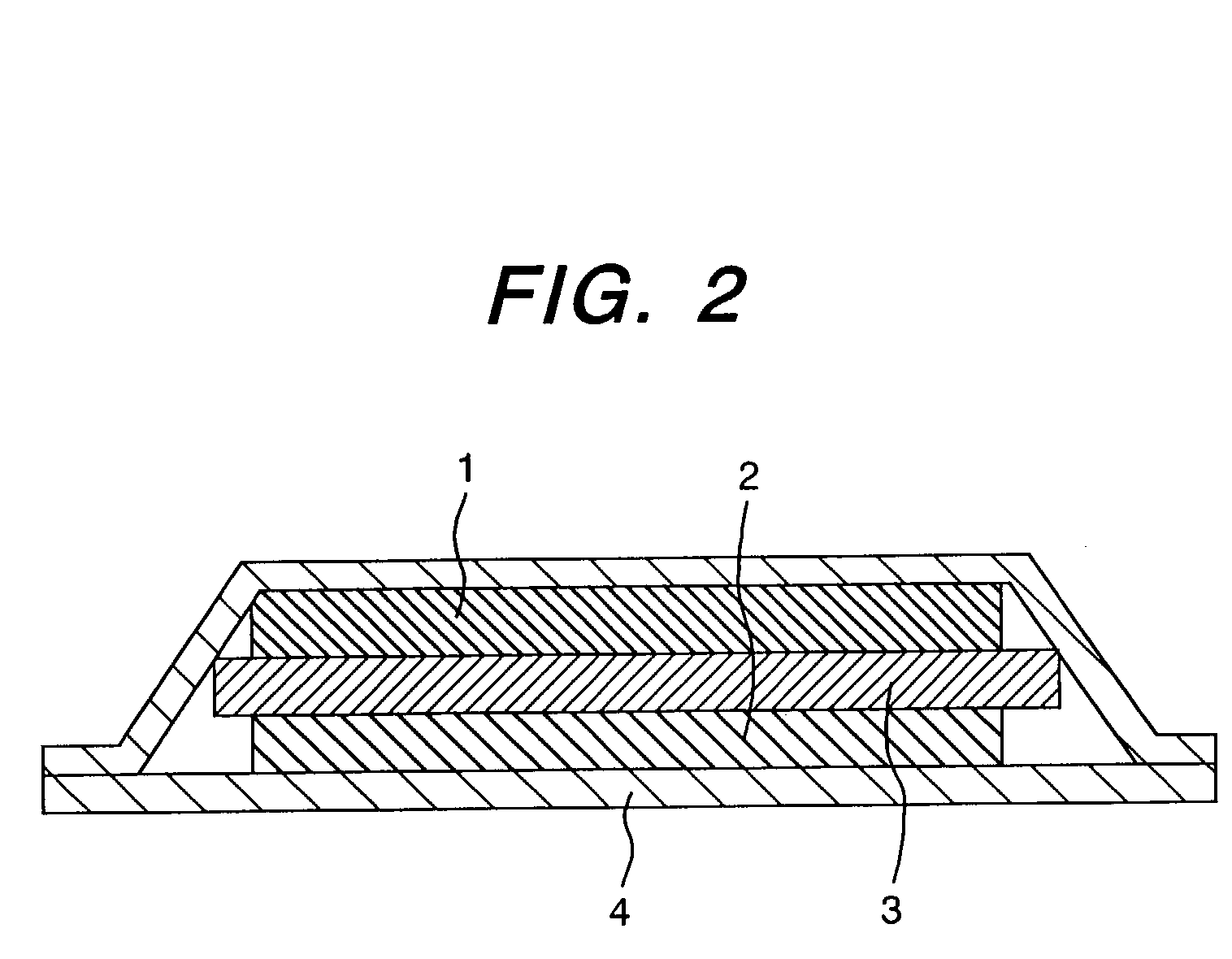Cationic conductor, its intermediate, and lithium secondary battery using the conductor
a technology of cationic conductors and secondary batteries, which is applied in the direction of non-metal conductors, cell components, conductors, etc., can solve the problems of difficult to secure the safety of batteries
- Summary
- Abstract
- Description
- Claims
- Application Information
AI Technical Summary
Problems solved by technology
Method used
Image
Examples
example 1
[0043]232 Grams of salicylic acid and 283 grams of 1-hydroxybenzotriazole were completely dissolved in a mixed solvent consisting of 3 dm3 of tetrahydrofuran and 2.5 dm3 of N,N′-dimethylformamide, the solvent having been dried by evaporation. The solution was stirred at room temperature for 30 minutes.
[0044]The solution was then cooled to zero° C., and 287 grams of 1-[3-(dimethylamino)propyl]-3-ethyl carbodiimide was dropped in the solution, followed by stirring at zero° C. for 30 minutes. To the solution slowly dropped was 2 dm3 of tetrahydrofuran containing 245 grams of vinylaniline and cooled to zero° C., followed by stirring the solution at room temperature for 2 days.
[0045]The reaction solution was condensed to extract an ethyl acetate phase from ethyl acetate and hydrochloric acid of 2 normals. The extract was rinsed with hydrochloric acid and saturated sodium chloride solution and drying with sodium sulfate, followed by condensation and purification to obtain white powdery
[00...
example 2
[0050]259 Grams of dihydroxybenzoic acid and 283 grams of 1-hydroxybenzotriazole were completely dissolved in a mixed solvent consisting of 3 dm3 of tetrahydrofuran and 2.5 dm3 of N,N′-dimethylformamide, the solvent having been dried by evaporation. The solution was stirred at room temperature for 30 minutes.
[0051]The solution was then cooled to zero° C., and 287 grams of 1-[3-(dimethylamino)propyl]-3-ethyl carbodiimide was dropped in the solution, followed by stirring at zero° C. for 30 minutes. To the solution slowly dropped was 2 dm3 of tetrahydrofuran containing 245 grams of vinylaniline and cooled to zero° C., followed by stirring the solution at room temperature for 2 days.
[0052]The reaction solution was condensed to extract an ethyl acetate phase from ethyl acetate and hydrochloric acid of 2 normals. The extract was rinsed with hydrochloric acid and saturated sodium chloride solution and drying with sodium sulfate, followed by condensation and purification to obtain white pow...
example 3
[0057]356 Grams of 2,6-dimethoxybenzoic acid was completely dissolved in 1 dm3 of vaporization-dried N-methyl pyrrolidone. To the solution added were 280 ml of triethylamine, 805 grams of (2,3-dihydro-2-thioxo-3-benzolyl)phosphonate and 260 ml of aminostyrene. The solution was stirred at room temperature for one day. The reaction solution was dropped in 8 dm3 of aqueous solution of 1% sodium hydrogencarbonate, and then the solution was stirred. The precipitated solid was purified with ethylacetate / n-hexane to obtain solid.
[0058]
Intermediate III; N-(4-vinylphenyl)-2,6-dimethoxy benzoic amide
[0059]140 Grams of the resulting solid was completely dissolved in 5 dm3 of tetrahydrofuran, and then 0.4 gram of azobisisobutylonitrile was added. The solution was stirred at 65° C. The reaction solution was dropped in 10 dm3 of n-hexane to obtain polymer. 50 Grams of the polymer was completely dissolved in 2 dm3 of N-methyl pyrrolidone, and then 98 grams of lithium trisulfoneimide was added to t...
PUM
 Login to View More
Login to View More Abstract
Description
Claims
Application Information
 Login to View More
Login to View More - R&D
- Intellectual Property
- Life Sciences
- Materials
- Tech Scout
- Unparalleled Data Quality
- Higher Quality Content
- 60% Fewer Hallucinations
Browse by: Latest US Patents, China's latest patents, Technical Efficacy Thesaurus, Application Domain, Technology Topic, Popular Technical Reports.
© 2025 PatSnap. All rights reserved.Legal|Privacy policy|Modern Slavery Act Transparency Statement|Sitemap|About US| Contact US: help@patsnap.com



